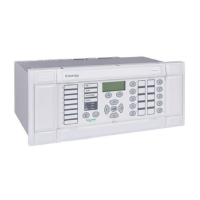P54x/EN OP/La4 Operation
(OP) 5-122
MiCOM P543, P544, P545 & P546
OP
2.3.3 Clock source
A clock source is required to synchronize data transmissions between the system ends. This
may be provided either by the P54x relays (internal) or may be a function of the
telecommunications equipment (external). The P54x relays have a setting for each of
Channel 1 and Channel 2 to set the Clock Source to either “Internal” or “External” according
to the communications system configuration.
This setting is not applicable if IEEE C37.94 mode selected.
2.3.4 Communication alarm
A comm
unication alarm is raised by the relay if the message error rate exceeds the setting
value under PROT COMMS/IM64/ Alarm Level (default = 25%) and persists over a defined
period of time (refer to section 2.1.6 below). This is equivalent to a Bit Error Rate (BER) of
1.5 x 10
–3
.
A communication alarm is also raised if the received message indicates failure of the
signaling channel at the remote end.
2.3.5 Communication error statistics
To aid the bit erro
r evaluation of the communication link, communication error statistics are
kept by the relay. These give the number of Errored messages detected, the number of Lost
Messages, and the number of Valid Messages received for each of the two channels. The
number of errored messages detected complies with ITU-T G8.21 and is as follows:
Number of errored seconds
Number of seconds containing 1 or more
errored or lost messages
Number of severely errored seconds
Number of seconds containing 31 or more
errored or lost messages
Number of degraded minutes
Number of minutes containing 2 or more
errored or lost messages
Note any severely errored seconds are ignored when working out the minute intervals
The number of lost messages recorded is intended as an indicator for noises under normal
communication conditions and not for recording long communication breaks. The lost
message count is accumulated by incrementing a counter when a message is rejected by
the Error code check, message length check and the sequential time tag check.
The error statistics are automatically cleared on power-up. They can also be cleared using
the Clear Statistics setting in Measurements column of the menu.
2.3.6 Communications delay timer
The
communications delay timer is the maximum difference in the measured channel
propagation delay time between consecutive messages that the relay will tolerate before
switching the settings, as described in section 2.1.6.
This
setting is factory set to 350 s. It should be increased to a suitable value if the
propagation delay time is expected to vary considerably such as in the case of a microwave
link with multiple repeaters.
2.3.7 Communications fail timer
The
communication fail timer is the time during which communication errors must be
continuously detected before the channel is declared failed. This governs the
implementation of the communication alarm and the ‘Protection Scheme Inoperative’ alarm.
The setting is normally set to the maximum of 10 seconds so that the two alarms will not be
affected by short bursts of noises or interruptions. The communication fail time setting
however may be set to a lower value of say 200 or 300 ms if the alarm contacts are to be
used for enabling standby protection, or to signal a change-over to reserve communication
facilities should the communication link become noisy or fail completely.

